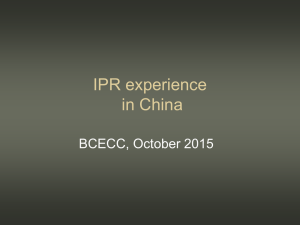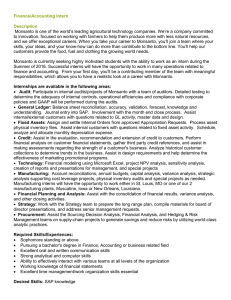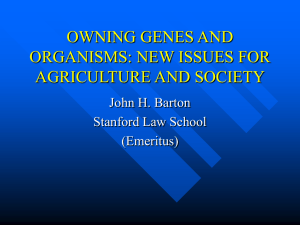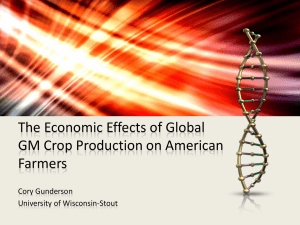MONSANTO v. SCHMEISER The U.S. Perspective
advertisement
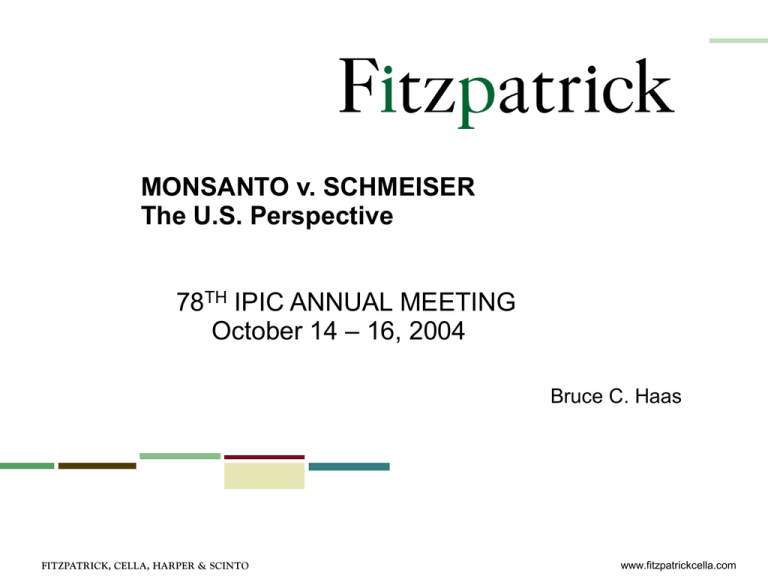
MONSANTO v. SCHMEISER The U.S. Perspective 78TH IPIC ANNUAL MEETING October 14 – 16, 2004 Bruce C. Haas www.fitzpatrickcella.com 35 U.S.C. § 101 •Whoever invents or discovers any new and useful process, machine, manufacture, or composition of matter, or any new and useful improvement thereof, may obtain a patent therefor, subject to the conditions and requirements of this title. 2 www.fitzpatrickcella.com The U.S. Supreme Court has concluded that living things are patentable under 35 U.S.C. § 101 •In J.E.M. Ag Supply, Inc. v. Pioneer Hi-Bred Int’l Inc., 534 U.S. 124, 145 (2001), the Supreme Court held that a newly disclosed plant breed falls within the subject matter of 35 U.S.C. § 101. – Over 2000 U.S. utility patents directed to plants had issued between Diamond v. Chakrabarty, 447 U.S. 303 (1980) and J.E.M. Ag Supply. – The Court in J.E.M. Ag Supply affirmed the broad applicability of Chakrabarty. 3 www.fitzpatrickcella.com – The Court found no irreconcilable differences between the different forms of protection for plants available in the U.S. – The Court addressed post-sale restrictions. Specifically, what can farmers do with seeds of the patented plant after purchase. 4 www.fitzpatrickcella.com •The Plant Variety Protection Act (PVPA) and Plant Patent Act (35 U.S.C. §§ 161-164) also can provide protection in the U.S., but these protections do not override § 101. •Due to the more stringent requirements to obtain a utility patent (applicant must present a new, useful, nonobvious invention and meet the requirements of 35 U.S.C. § 112), utility patent holders receive greater benefits than provided by either the Plant Patent Act or the PVPA. 5 www.fitzpatrickcella.com PLANT PATENT ACT •In U.S., patent protection is available under the Plant Patent Act for asexually reproduced plants (those produced from cuttings or grafts (not grown from seeds) (35 U.S.C. §§ 161-164). – Limited to distinct and new plant varieties. – Single claim to the plant as shown and described. – Limited applicability – grants rights to exclude others from asexually reproducing the plant, and from using, offering for sale, or selling the plant so reproduced (35 U.S.C. § 163). 6 www.fitzpatrickcella.com PLANT VARIETY PROTECTION ACT •In 1970, U.S. Congress enacted the Plant Variety Protection Act. •The PVPA confers protection to sexually reproduced plants that are new, distinct, uniform and stable (7 U.S.C. § 2402(a)). •The PVPA permits a plant breeder to protect seed crops with a certificate of plant variety protection from the Secretary of Agriculture. This certificate grants the breeder the right to exclude others from selling the variety, or offering it for sale, or reproducing it for 20 years (7 U.S.C. § 2483). 7 www.fitzpatrickcella.com PLANT VARIETY PROTECTION ACT (Cont.) •The PVPA contains a “crop exemption” allowing – A farmer to save seed for replanting. “[I]t shall not infringe any right hereunder for a person to save seed produced by a person from seed obtained, or descended from seed obtained, by authority of the owner of the variety for seeding purposes and use such saved seed in the production of a crop for use on the farm of the person . . .” (7 U.S.C. § 2543). •The PVPA also contains a “research exemption” (7 U.S.C. § 2544). 8 www.fitzpatrickcella.com •In the U.S., the holder of a certificate of plant variety protection cannot use that certificate to prevent a farmer from saving seed. •However, in the U.S., one can also obtain a Utility Patent claiming a plant or living thing under 35 U.S.C. § 101. See Diamond v. Chakrabarty, 447 U.S. 303 (1980); J.E.M. Ag Supply, Inc. v. Pioneer Hi-Bred Int’l Inc., 534 U.S. 124 (2001). •Patentability depends on not whether the thing is living – but whether it is a human-made invention, whether living or not. J.E.M. Ag Supply, 534 U.S. at 130. 9 www.fitzpatrickcella.com •By enacting the PVPA, Congress never intended to exclude the possibility of plants being claimed in utility patents. •A U.S. utility patent affords the possibility of a claim directed to a plant, unlike in Canada. •In the U.S., the holder of a utility patent claiming a plant and a PVPA certificate may sue for infringement for post sale products without being restricted by the PVPA exemptions. See Monsanto Co. v. McFarling, 302 F.3d 1291, 1299 (Fed. Cir. 2002); 363 F.3d 1336, 1344 (Fed. Cir. 2004). 10 www.fitzpatrickcella.com •Monsanto Co. v. McFarling, 302 F.3d 1291, 1299 (Fed. Cir. 2002) – “It is thus established that the right to save seed of plants registered under the PVPA does not impart the right to save seed of plants patented under the Patent Act.” •Monsanto Co. v. McFarling, 363 F.3d 1336, 1344 (Fed. Cir. 2004) – “In light of the Supreme Court’s interpretation of Congress’s intent, we conclude that Congress did not intend to prohibit owners of utility patents from enforcing seed-saving prohibitions in their licenses.” 11 www.fitzpatrickcella.com •Monsanto Co. v. Scruggs, 249 F. Supp.2d 746, 756-757 (N.D. Miss. 2001) – “[T]he PVPA is no impediment to the enforceability of … patents.” Id. at 756. – “[E]ven if it were shown that Monsanto obtained PVPA certificates for its [patented] seeds and plants, the Federal Circuit’s decision in the Pioneer Hi-Bred case all but dictates the conclusion that the additional protections afforded Monsanto by virtue of the United States patent laws permit it to determine, within the confines of reason, how best to offer its patented discoveries for sale or use by others.” Id. at 757. 12 www.fitzpatrickcella.com The Common U.S. and Canadian Question When can a patentee (of a plant, seed or gene) place post-sale restrictions on the sale of the patented product? • Monsanto was able to succeed against Schmeiser based on its Canadian patent directed to a gene/cell. 13 www.fitzpatrickcella.com • In Canada, despite the lack of utility patents for plants, the Schmeiser case holds that a patentee can protect plants regenerated from patented cells. “Whether or not patent protection for the gene and the cell extends to activities involving the plant is not relevant to the patent’s validity.” Monsanto v. Schmeiser, 2004 SCC 34 at ¶24. – Saving and planting seed, then harvesting and selling plants that contained the patented cells and genes, constitute “utilization” of the patented material within the meaning of s. 42 of the Patent Act. Id. at ¶69. – The same result would likely occur in the U.S. if Monsanto had a patent to the plant, gene or cell. 14 www.fitzpatrickcella.com • In the U.S., utility patent claims can also restrict post-sale activity. See J.E.M. Ag Supply, Inc. v. Pioneer Hi-Bred Int’l Inc., 534 U.S. 124 (2001). • In the U.S., courts have found that “bag tags” (like shrink wrappers) can effectively license “one time use” of plants or seeds. See Pioneer Hi-Bred Int’l, Inc. v. Ottawa Plant Food, Inc., 283 F. Supp.2d 1018, 1035-1049 (N.D. Iowa 2003). 15 www.fitzpatrickcella.com •Pioneer Hi-Bred Int’l, Inc. v. Ottawa Plant Food, Inc., 283 F. Supp.2d 1018, 1035-1049 (N.D. Iowa 2003) – “The court [found] that the meaning of the clear, unambiguous language of the bag labels at issue in this case is that the only right granted to a buyer was the right to use the seed to produce forage or grain, thereby reserving all other rights to the patentee, including the right to sell or resell.” Id. at 1039. – “The bag label and bag tag unambiguously grant only a right to use the seed … to produce grain or forage; the label and tag unambiguously do not grant a buyer the right to resell [patented] seed.” Id. 16 www.fitzpatrickcella.com •In the U.S. it has been found that “mistaken planting” of patented seeds is not a defense to patent infringement (Monsanto v. Dawson, 2000 WL 33953542, *2 (E.D. Mo., Nov. 24, 2000)). •“Lack of knowledge” of post sale restrictions or patent coverage is not a defense to patent infringement in the U.S. (Monsanto v. Hartkamp, 2001 WL 34079482, *2 (E.D. Okla., April 19, 2001)). •“Lack of any formal execution” of a one-time limited license is not a defense to patent infringement in the U.S. (Monsanto v. Scruggs, 249 F.Supp 2d 746, 754 (N.D. Miss. 2001)). •“Lack of intent” is not a defense to patent infringement in the U.S. (Monsanto v. Roman, 2004 WL 1107671, *9 (N.D. Tex., May 17, 2004); See also, Monsanto v. Hartkamp). 17 www.fitzpatrickcella.com In the U.S., there is tension between the doctrine of patent exhaustion and one-time use restrictions •The premise of the doctrine of patent exhaustion is that the first sale by a patentee of an article embodying his invention exhausts his patent rights in the article. See Bangad, Inc. v. Al Bolser's Tire Stores, Inc., 750 F.2d 903, 924 (Fed.Cir.1984), citing United States v. Univis Lens Co., 316 U.S. 241, 250-52 (1942). •While the doctrine might appear to benefit an accused infringer, the Federal Circuit and the district courts have held that the restrictions in licensing agreements against using patented seeds or plants to produce additional seeds for planting do not violate the patent exhaustion and first sale doctrines. 18 www.fitzpatrickcella.com •Monsanto Co. v. McFarling, 302 F.3d 1291 (Fed. Cir. 2002). – The Federal Circuit Court held that Monsanto’s licensing agreements prohibiting saving seeds did not violate the doctrines of patent exhaustion and first sale because the restrictions in the agreements were within the scope of Monsanto’s patent rights. Id. at 1298. – The Court reasoned that “[t]he ‘first sale’ doctrine of exhaustion of the patent right is not implicated, as the new seeds grown from the original batch had never been sold” and that “[t]he original sale of the seeds did not confer a license to construct new seeds.” Id. at 1299. 19 www.fitzpatrickcella.com •Monsanto Co. v. Scruggs, 249 F. Supp.2d 746, 756-757 (N.D. Miss. 2001); 2004 WL 1535690, *11 (N.D. Miss., July 6, 2004). – The Court held that Monsanto’s single use restriction was valid because it falls within the patent grant (relates to subject matter within the scope of the patent claims). – The Court found that Monsanto never made an unrestricted sale of its seed technology. Since Monsanto never made an unrestricted sale of its technology, the Court ruled that “the doctrine of first sale/patent exhaustion afford [sic] no protection to the [defendants].” 2004 WL 1535690, *11. 20 www.fitzpatrickcella.com •Monsanto Co. v. Trantham, 156 F. Supp.2d 855, 869-870 (W.D. Tenn. 2001) – The Court ruled that the doctrine of exhaustion did not bar Monsanto’s claims for patent infringement because the sale of Monsanto’s patented gene technology was “expressly conditioned on the signing of the restrictive licensing agreement that prohibits the saving of seed and restricts the use of the seed to a single growing season.” 21 www.fitzpatrickcella.com •Pioneer Hi-Bred Int’l, Inc. v. Ottawa Plant Food, Inc., 283 F. Supp.2d 1018, 1031-1035 (N.D. Iowa 2003) – The Court granted summary judgment for the patentee because “there was no ‘first’ unconditional sale.” Id. at 1034. – The Court reasoned that “in the face of undisputed evidence that the sales were conditional, the ‘patent exhaustion’ defense is simply inapplicable as a matter of law.” Id. at 1033. 22 www.fitzpatrickcella.com A U.S. court faced with the Schmeiser facts would likely find the same way •U.S. courts would have no problem with the scope of Monsanto’s utility patent. •Likely that a U.S. court would find that collecting, saving and planting seeds containing Monsanto’s patented gene and cell would constitute a “use” under 35 U.S.C. § 271(a). See Monsanto v. Swann, 308 F. Supp.2d 937, 941 (E.D. Mo. 2003). •Lack of knowledge or intent is not a defense to patent infringement. Intent only goes to willful infringement and damages. 23 www.fitzpatrickcella.com •Damages issues could differ. – U.S. courts may be more inclined to award actual damages based on number of bags of seeds saved and replanted (Monsanto v. McFarling, 363 F.3d 1336, 1352 (Fed. Cir. 2004)). – Since the Canadian Supreme Court does not focus on Schmeiser’s intent or knowledge in determining the appropriate remedy, it is unclear whether a U.S. court would have awarded damages differently. 24 www.fitzpatrickcella.com
